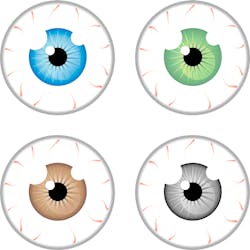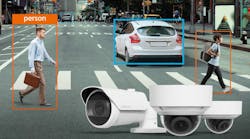Long viewed as a solution for specialized security applications with large areas to monitor, multi-sensor cameras have been expanding into more mainstream usage of late. There are a number of economic and performance-based factors that have helped create a shift in the overall video surveillance space given the increased awareness and deployment of these cameras in more broad-based applications.
By combining up to four individual sensors – or camera heads – into a single housing, multi-sensor cameras can replace multiple cameras, and the ability to deliver high-quality 180° or 360° panoramic views of a scene, these cameras deliver greater detail across larger coverage areas and improved wide area surveillance with significantly reduced blind spots. This allows video systems to be designed with fewer cameras to cover the same – or larger – areas of interest, which often reduces initial investment costs associated with a system.
Below are three main factors that are changing the video surveillance landscape by moving multi-sensor cameras into the mainstream.
Cost Savings
As mentioned above, there is a tremendous value proposition in multi-sensor cameras. When properly positioned, a single multi-sensor camera can replace several fixed and/or PTZ cameras for maximum cost-effectiveness reduced total cost of ownership (TCO) and increased return on investment (ROI). Many multi-sensor cameras also offer advanced video analytics to produce real-time business data that can be used to increase sales, plan for future events and review overall security implementation and effectiveness – further contributing to their value and ROI.
In addition to the cost of equipment, another key expense related to video surveillance equipment is the installation. Depending on the time required to run wire, install conduit and other factors, installation costs can run quite high. However, the less related infrastructure and other equipment that must be installed, the lower those costs will be. This is where multi-sensor cameras offer tremendous advantages over single-sensor cameras. In some cases, the savings on installation can virtually eliminate the difference in cost between multi- and single-sensor cameras.
For example, where at one time you may have had to install four cameras with four separate data and power connections, in many cases you can now install a single camera and single connection, also known as a drop. When you consider the cost of running one conduit to a location as opposed to four, which cost four times as much, the price of the camera becomes relatively insignificant in the grand scheme of things.
Licensing is another area where multi-sensor cameras offer savings over single-sensor cameras. In most cases, a multi-sensor camera has one IP address, which requires only one license for the video management system. This reduces expenses while offering greater ability to integrate video with access control, building management, fire control and other systems to increase overall security and potentially improve operational efficiencies.
After deployment, multi-sensor cameras continue to deliver potentially significant savings with regard to ongoing maintenance. In the event of an outage, for instance, an installer will only need to troubleshoot and repair one camera and/or connection, which will save time at the job site and reduce labor costs.
All of these factors contribute to a lower TCO and higher ROI with multi-sensor cameras compared to single-sensor models.
Advanced Technologies
Many of the most cutting-edge technologies have made or are making their way into multi-sensor cameras to deliver even greater performance and value. Among these is low-light performance, which has evolved substantially in recent months and years.
In the past, high resolutions were the primary culprit for surveillance cameras’ poor low-light performance. Thankfully, manufacturers have made tremendous progress in incorporating sensors that are much more sensitive to light into their cameras today. These sensors, combined with day/night cut filters have made it possible for multi-sensor cameras to more effectively process video in low-light environments. As resolutions continue to increase, you can be sure that low-light performance will continue to increase as well.
Schools are a prime example of this technology in action. Because of budgetary constraints, schools are always looking for ways to save money, including turning off the lights when no one is in the building. With a multi-sensor camera with day/night capability, a school will no longer have to make a choice between monitoring the building with video and saving money on electricity. The camera will provide high-quality video that delivers the functionality the end user expects and essentially cuts through the darkness.
Today’s multi-sensor cameras are also highly intelligent, with many offering a wide range of video analytics. These include abandoned object detection, adaptive motion detection, camera sabotage, object or people counting, removed object detection and much more. All of these contribute to greater overall security by alerting system operators to any unusual or abnormal activity that may require follow-up or further investigation.
Situational Awareness and Investigation
One of the most vital elements of security is situational awareness or knowing exactly what is happening in a particular environment at any given time. This is critical for identifying and understanding a developing or active incident and responding appropriately and effectively. While virtually all surveillance video provides some degree of situational awareness, multi-sensor cameras deliver a number of significant advantages over single-sensor cameras.
Chief among these advantages is the ability to record the entire 180 or 360-degree field of view at all times. This reduces the number of cameras required to provide non-stop situational awareness. Multi-sensor cameras also overcome the challenge of asking security operators to monitor video from a large number of cameras. In some cases, multi-sensor cameras can reduce the number of video screens and feeds operators must oversee, but they also enable more effective monitoring of larger areas by improving the operator’s ability to view multiple areas of interest within a single field of view.
A multi-sensor camera with built-in video analytics across the wide viewing area can alert operators to incidents in real time, allowing them to view only those areas of interest that demand their attention – as opposed to monitoring several cameras to detect incidents. Once an operator receives an alert, he or she can digitally zoom in on a specific area within the wider scene for a more detailed view that leads to an immediate, appropriate response. At the same time, video from the entire scene continues to be recorded for later use, as needed.
Consider a scenario where four intersecting hallways must be monitored. A single-sensor PTZ camera mounted in the intersection can capture images down the length of each hallway, one at a time. But a multi-sensor megapixel camera can do much more than that. A single multi-sensor camera mounted at the intersection can view all four hallways simultaneously. This eliminates blind spots and makes sure critical details are captured and retained from all directions in a single view. By providing a high-quality video feed from all four directions, multi-sensor cameras ensure that if an incident occurs the camera will never be pointed in the wrong direction at the wrong time. When mounted on a ceiling in a lobby or waiting room, for example, these cameras will capture highly detailed images that deliver valuable situational awareness that can improve the speed, efficiency and effectiveness of a response. Some applications where these cameras have been deployed for this purpose include schools, malls, hospitals and other areas where there are a lot of people moving around.
In addition to vital situational awareness, multi-sensor cameras also contribute to more efficient investigations. Should video recordings need to be reviewed for post-incident forensics, having to sift through video from multiple overlapping single-sensor cameras can be time-consuming. Conversely, the single view provided by multi-sensor cameras is much easier and faster. With less video to sift through, a multi-sensor camera saves security staff and investigators significant time and effort when searching for critical forensic data following an incident. And the camera also provides high-quality video, which can serve as excellent evidence for potential prosecution or other necessary action.
The Purchase Proposition
With these factors in mind, it’s easy to see that multi-sensor cameras are simply designed to make the overall design, installation, maintenance, and post-event forensic analysis simpler. A single housing with multiple sensors will do the job of several single-sensor cameras, significantly simplifying the application and installation in terms of cabling, connections and VMS licenses. When you factor in these savings, multi-sensor cameras provide up to four cameras for the price of one in many scenarios, providing more coverage and more bang for your buck.
Considering all the economic and performance benefits multi-sensor cameras deliver over their single-sensor counterparts, it should come as no surprise that these cameras are moving more into the mainstream and making a significant impact on today’s video surveillance landscape.
About the Author: Ryan Zatolokin is a Business Development Manager and Senior Technologist for Axis Communications, Inc.


